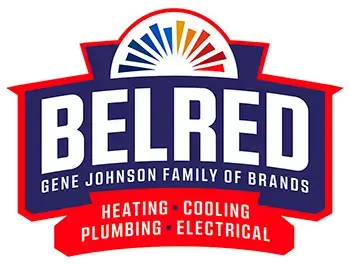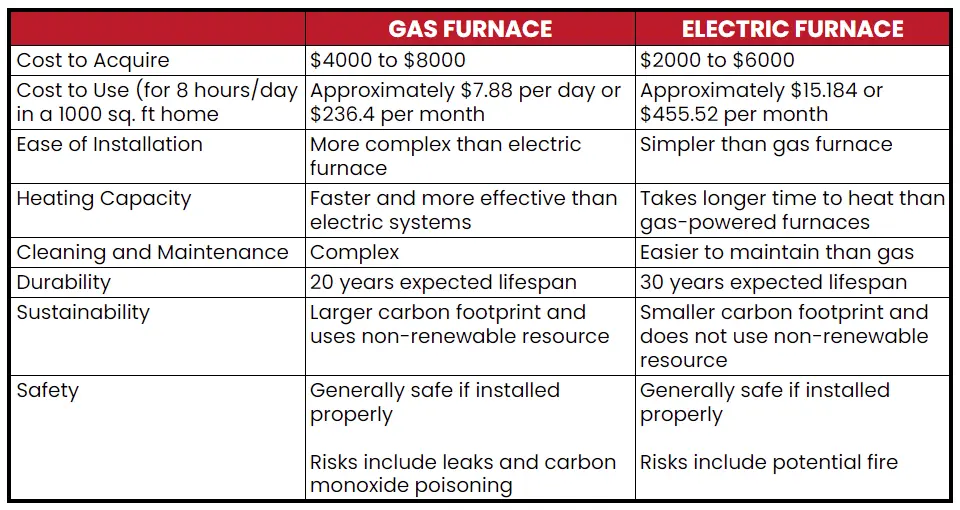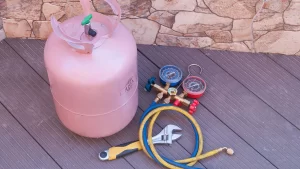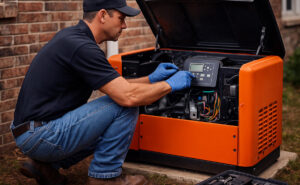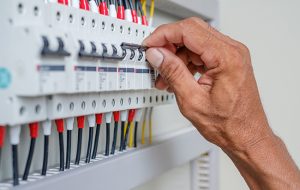A furnace is a big metal box with a fan and heating elements that send heated air throughout your house. It’s a necessary appliance—especially if you live in a cold state like Washington.
Many homeowners face the confusion of choosing between a gas or electric furnace. It can be a long-standing dilemma.
We’ll outline the differences between a gas and electric furnace across a handful of essential categories so you can narrow things down and make the best buying decision. Whether you’re looking to get a furnace for the first time or replace an old one, this post is for you.
Here are the categories worth noting:
1. Cost to Acquire
The upfront cost is understandably on top of your considerations list when comparing gas and electric furnaces. After all, the price sticker is the first thing you’ll see at a store. However, the unit prices don’t tell the whole story when comparing acquisition costs.
Legally speaking, you’re not allowed to install your own furnace, whether it’s electric or gas. This is because a furnace has complex parts that can cause serious problems if not installed correctly.
For this reason, you will need to consider installation costs from a contractor. More often than not, this includes professional labor, permit procurement, supplies, inspection after the job is done, and a standard workmanship guarantee.
A fully installed gas furnace costs anywhere from $4000 to $8000, and the variation is relative to the brand and features. On the other hand, the price of a fully installed electric furnace ranges from $2000 to $6000.
It is crucial to remember that if extensive upgrades are required to your existing ducting or if no ductwork is in place, the overall cost of the service may increase. Removal and disposal of an outdated furnace and additional materials essential to finish the installation may also be included in the total cost.
2. Cost to Use
Because you expect to use your furnace for many years, it stands to reason that you pick one that will cost you less in the long run.
To help you compare these costs objectively, let’s assume that you live in a 1,000-square-foot home. A house this size needs approximately 45,000 BTU per hour to keep a reasonable temperature. Let’s also assume that you use your furnace for 8 hours a day during cold winters.
As of this writing, a therm of natural gas in Washington state costs $1.970. You will need four therms to run the gas furnace for 8 hours. This translates to a $7.88 cost per day and $236.4 for a 30-day month.
To compute the consumption of electric furnaces, take note that 1kWh of power is 3,412 BTU, and hence 45,000 BTU equals around 13 kWh. As of this writing, the cost of electricity in Washington is 14.6 cents per kWh. If we multiply this rate by 13 kWh and multiply it again by 8 hours, we’ll arrive at a $15.184 cost per day. The cost per month would then be $455.52.
Judging from these computations, one can easily deduce that a gas furnace is a more cost-effective and energy-efficient model. Although one must take note that gas prices are deemed more volatile than electricity, so these numbers might change in the future.
Keep in mind, however, that these theoretical costs are for comparison purposes only. Local temperatures, the actual size of your home, regional fuel costs (for a gas furnace), regional electricity costs (for an electric furnace), and the energy efficiency of your equipment can all affect your monthly heating expenditures.
3. Ease of Installation
We mentioned installation earlier in this article from a cost standpoint. But apart from the expense, you should also consider how these furnaces have different heating systems and, by extension, different installation processes. One might be more suitable for your building than the other.
For instance, the installation is much more complicated with gas systems than electric ones. You will need a natural gas line running through your home or office, and a gas meter will need to be installed.
Also, if you don’t already have a chimney or an outside vent, a professional must install one. From this, you can see why installing a gas unit is often more costly.
Meanwhile, electric systems and heat pumps are far simpler to install and much easier to replace when they wear out.
4. Heating Capacity
Gas furnaces have an advantage in this regard. The combustion chamber and gas jets in these systems can send hot air throughout your house faster than electric furnaces.
But we must always remember that this difference may not be around for long. As technology progresses, electric-powered furnaces with forced air heating systems will soon close this gap. This is why the heating capacity may just be a small factor in the decision-making process for many homeowners.
5. Cleaning and Maintenance
Electric furnaces are generally easier to maintain. They do not have gas-powered burners and combustion chambers that need to be inspected or cleaned, so they are often less expensive to service than gas furnaces.
Gas furnace repair expenses are often greater than electric furnaces since they are more complex and have higher related labor costs. Because there is always a risk of carbon monoxide poisoning, annual inspections of gas furnaces are strongly recommended.
Electric furnace repairs are frequently less than $300, while gas furnace repairs can range from $300 to $1,200.
6. Durability
Another significant distinction between gas and electric furnaces is durability. Electric furnaces are built to last much longer than their gas counterparts, saving you money in the long run.
A typical electric furnace would last for more than 30 years, while with a gas furnace, you’ll be fortunate if it lasts 20 years with consistent care and regular maintenance.
The extra ten years difference might be a big deal for you, but remember that electric furnaces lose energy efficiency over time, which means they might cost you more to operate in the latter parts of their lifespan.
7. Sustainability
The sustainability category refers to the impact of using both furnaces on the environment. This can be measured through two factors: carbon footprint and resource depletion.
It should come as no shock that when talking about sustainability, electric furnaces are better than gas furnaces on all fronts. Natural gas furnaces emit about 50% more carbon dioxide than their electric counterparts, which is a major contributor to global warming. In addition, they produce more nitrogen oxides (which contribute to respiratory problems) and sulfur dioxide (which causes acid rain).
Natural gas is also a non-renewable resource, meaning continuous use of it will eventually lead to depletion.
8. Safety
Above all, a furnace should be safe. Electric and gas furnaces both have respective advantages and disadvantages regarding safety.
Gas furnaces are powered by natural gas delivered to your home through a gas line. This means there’s always a risk of leakage inside your house, which could be dangerous if left unchecked. The good news is that modern gas furnaces have sensors that detect leaks and shut them off automatically before they can cause any problems.
Any gas product also carries the danger of carbon monoxide poisoning. Regular maintenance and the installation of carbon detectors may considerably reduce this risk.
Electric furnaces are generally safer than gas ones because they won’t leak and won’t exhume carbon monoxide. However, they can still pose significant risks if you don’t have adequate grounding circuits installed throughout your house.
Difference Between Gas and Electric Furnace at a Glance
We’ve summed up all the pointers of our discussion in an easy-to-read table below:
Bottom line is, when comparing gas vs. electric heating systems, the choice comes down to which matters more to you and which one is better for your place. If you want a lower upfront cost, go with electric. If being energy efficient and having lower operating costs are your priority, then, by all means, go for one of those gas units.
Remember to do thorough research before determining which one best suits your home or office. For example, if your building already has a dedicated gas line, you might be better off with a gas furnace.
Your HVAC System Needs Routine Maintenance
Whether you own an electric or gas furnace, it’s vital to maintain it properly. Without proper upkeep, your heating and cooling system could break down in the middle of a cold winter or during a heat wave—and that would be a disaster.
Over time, dust and dirt buildup will affect many parts of an HVAC system, including the heat pump, heat exchanger, and air conditioner, causing these appliances to potentially fail. Thorough and consistent cleaning can prevent this from happening.
Routine maintenance includes the following important steps:
- Checking for any leaks in the gas heating system or faulty electrical connections in an electric system.
- Regular filter cleaning prevents dust from entering the system and causing damage over time. A clean filter also translates to clean indoor air.
- Regular cleaning of electric coils helps prevent overheating and improves efficiency by allowing airflow through more easily when needed.
One-stop HVAC Repair and Maintenance
If you’re looking for a company to care for all your heating and cooling needs, look no further than BelRed. Our team can handle everything from installation to repair and maintenance of HVAC systems!
We have been servicing the Mukilteo area since 1986, so we know what it takes to keep homes comfortable year-round. Plus, we have the best reviews!
Call (855) 345-6161
Call our lines today to book a service or get a free consultation!
